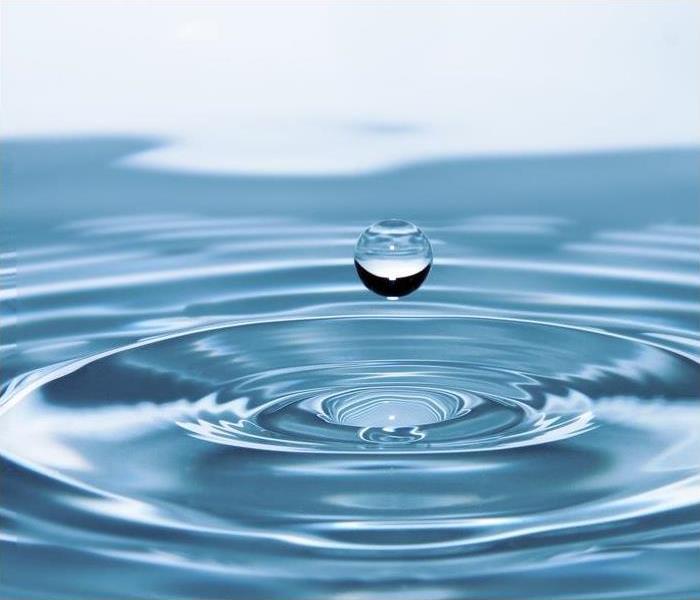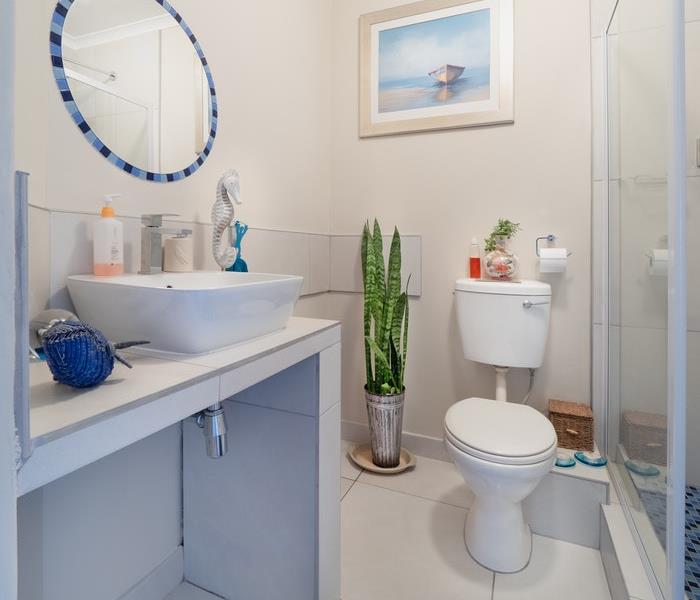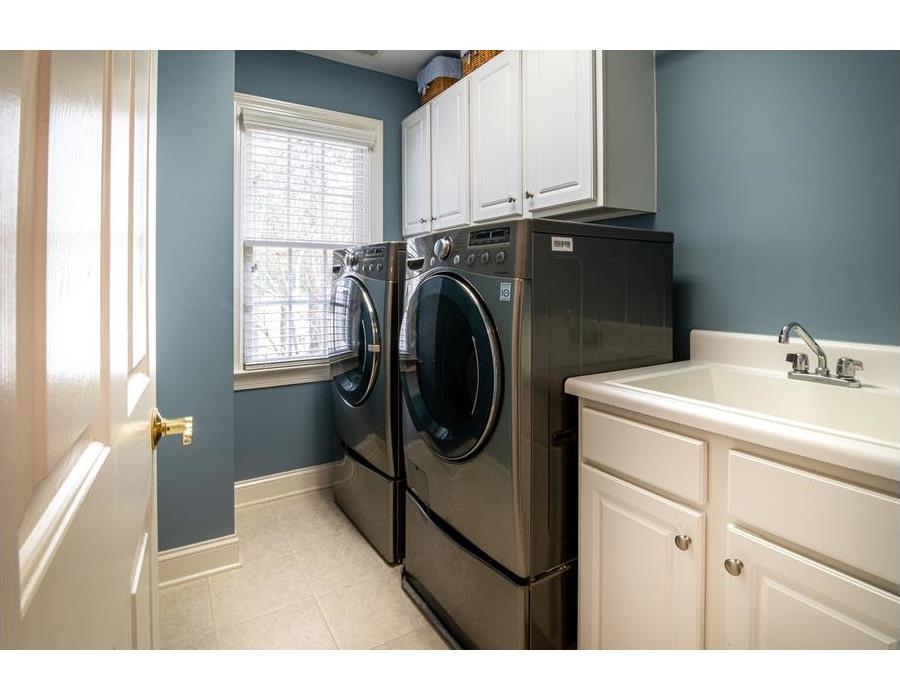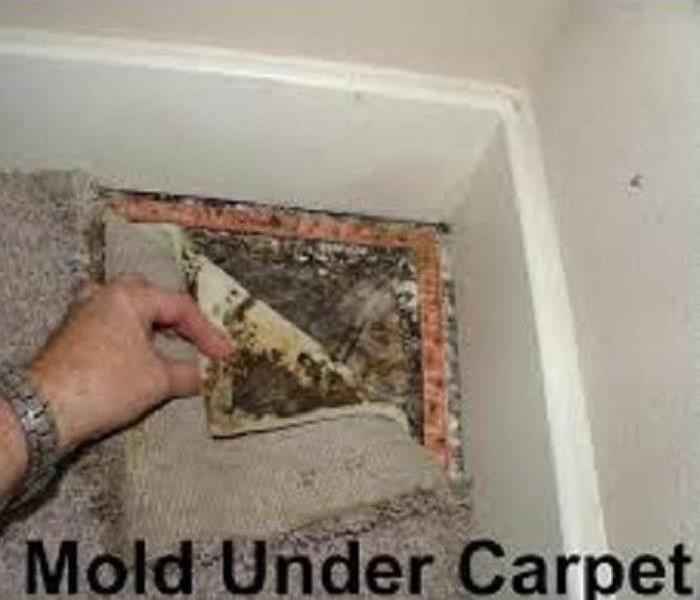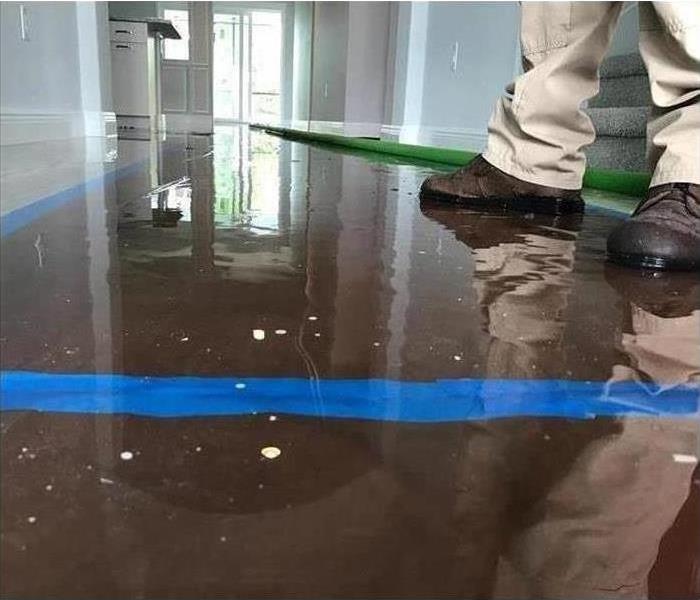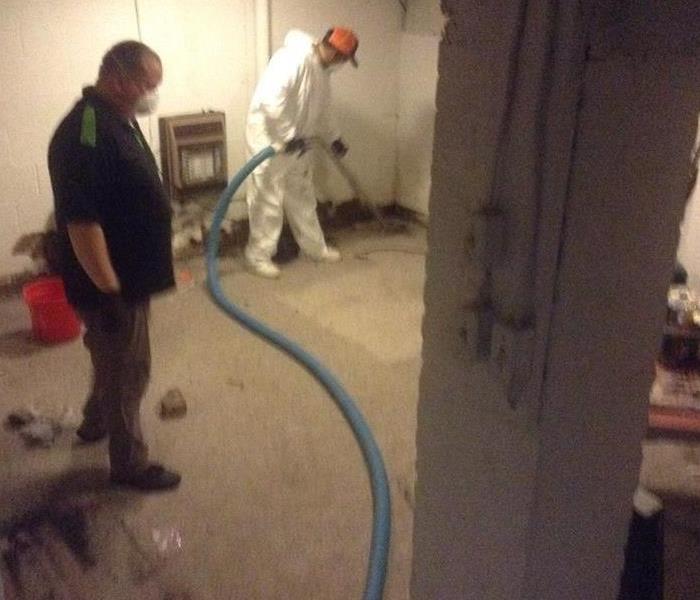Recent Water Damage Posts
Testimonial
11/7/2024 (Permalink)
Mrs. ShifflettHuntsville AL8/2024 "SERVPRO came out to do demolition for a toilet that had overflowed on our second floor and seeped through the living room ceiling. The team did a phenomenal job of prepping the area and getting the demo done in what I thought was record time. Liz, Will, Kaitlyn and Jordan left the Space cleaner than when they arrived. They were also super quick filing paperwork to our insurance company making the whole process so very smooth. Would highly recommend their services!" Tara, thank you so much for your kind review! We were able to recognize the team members you mentioned for executing such a professional job.
Huntsville, AL Water Damage Cleanup and Restoration Services
11/27/2023 (Permalink)
- 24-Hour Emergency Service
- Faster to Any Size Disaster
- Highly Trained Water Restoration Technicians
- A Trusted Leader in the Water Restoration Industry
- Locally Owned and Operated
- Veteran Owned
- Advanced Water Inspection, Extraction, and Drying Equipment
Huntsville, not only the fastest growing city in Alabama, but also the state’s largest city. Nearly 400,000 residents call Huntsville and Madison County home, with almost 9,000 University of Alabama Huntsville students. With multiple storm events in the area annually, it’s important to keep your home, apartment or business dry when water damage occurs. SERVPRO® franchise professionals are ready to help right now.
When homes and businesses in the Huntsville, AL area require the best in water-fire-mold restoration, we’re Here to Help®
The Huntsville area has many museums, sporting events and nature attractions. Within the city, there are more than 65 parks featuring over 3,000 acres. Weather in Huntsville can be unpredictable, with severe storms, wind and tornadoes being a concern in the spring and summer months. Huntsville businesses need help right away when a water damage or flooding emergency occurs. You can count on our Madison County franchises for your restoration needs. We have locally owned and operated locations near you that are available today to take care of your emergency. Our residential and business services include:
Our locally owned and operated SERVPRO franchises are available 365 days a year, 24 hours a day. Give us a call, and we will make it “Like it never even happened.”®
Our commercial cleaning professionals are trained to follow CDC protocols for all types of specialty cleaning services for hazardous materials including the novel coronavirus, biohazard and mold removal.
Contact your local SERVPRO for a free, no-obligation consultation with our team of IICRC certified damage restoration specialists. No matter the amount of damage, SERVPRO has over 50 years of experience and over 1900 franchises nationwide.
Most Common Causes of Water Damage
4/14/2022 (Permalink)
About 40% of all homeowners have experienced a loss from water damage. It can spread contamination, ruin your paint and damage your wood. The good news is that 93% of all water damages could have been prevented with the right knowledge. How can you protect your home from residential water damage? Here are seven ways to prepare.
1. DAMAGED PIPES
Plumbing systems, especially in older homes, are susceptible to stoppages and damage. To prevent plumbing problems before they start, be on the lookout for cracks, bulges, stains and other signs of moisture on your ceiling or floors. If you spot a leak, it could be a sign that there is damage in other areas as well. Spikes in your water bill could mean you have additional damage to your landscaping, flooring and foundation. Look out for pipes in areas prone to collecting water, such as crawl spaces, cabinets and attics. If you see any signs of water damage, call a plumber right away to avoid larger problems in the future. Be sure to check and insulate your pipes every year before winter begins. Pipes can rupture and freeze within a few hours, soaking your entire house.
2. APPLIANCES
As appliances get older, their pipes can rust and their hoses can weaken. Dishwasher leaks can leave an unwelcome puddle on your kitchen floor. Common causes include worn gaskets, broken doors and clogged drains. It can cause damage to your tile, electrical wiring and paint. A great way to prevent buildup in your dishwasher is to run a quart of vinegar through the machine each month. You can also scrape and rinse before you load it.
Flooding caused by washing machines is usually caused by leaky hoses. The leak can worsen over time and cause damage to your home. A washing machine valve shutoff kit can prevent the six gallons of water per minute from flooding into your home.
Refrigerators produce a lot of access water that can pool on the bottom of them. Drain lines can also become clogged. If there is a leak in the water supply line that feeds your ice machine, you could come home to a lot of standing water. To prevent your refrigerator from flooding, be sure that it is well insulated. Make sure that you do not move it in and out of its normal position too often, and inspect it regularly for leaks.
3. CLOGGED DRAINS
Bathroom and sink drains can become quickly clogged with dirt, grease, hair and other substances. Pipes can break down, and structural damage is common. If drain clogs are not cleared, problems such as disease, sickness and aggravated health conditions could occur. If left unchecked, clogged drains can cause damage to other places in the home. For example, a clogged toilet can back up into your sink. You may even warp the floorboards and wall support. Small screens can help keep unwanted materials from clogging drains. Pouring boiling water down your drain once a month can help dissolve grease, soap scum and other debris before it clogs your pipes.
4. NATURAL DISASTERS
Hurricanes, breaking dams and snowstorms can all bring excessive water into your home, causing it to flood. Large amounts of water can’t be absorbed by the land, and may overflow into your home. A flood alarm and warning system can help you protect your home against a natural disaster. If you live in a coastal area, be sure to purchase additional flood insurance. Some folks living in flood-prone areas raise their homes on stilts to prepare for floods. Others install foundation vents or sump pumps. You can also grade your lawn away from the house. Make sure you know where the water main is and shut it off when you leave for an extended period of time. This way, you will not come home to any unwanted surprises.
5. HVAC UNITS
Heating, ventilation and air-conditioning systems within your home can cause floods. Be sure to have these systems inspected and cleaned regularly. If you know there is an impending storm, shut off your central air conditioning to prevent damage and risk of electrocution.
6. SUMP PUMP PROBLEMS
If your sump pump stops working, you could have a major flood in your basement. You will then have to deal with potential mold growth, water removal, and bacteria. To keep your sump pump working optimally, always make sure that it is standing upright. Be sure that the vent hole in the discharge pipe is clear. Your outlet pipes should be joined tightly together and drained out at least six feet from your location. If you notice any leaks in your sump pump, call a professional immediately.
7. STRUCTURAL DAMAGE
Moisture dripping through your concrete and crawl spaces can lead to mold and rotting. Check your home regularly for these signs. Cleaning your gutters regularly and maintaining your trees and vegetation will keep unwelcome water from damaging your walls and foundation. You can also install flood protection devices, such as an alarm that goes off when it detects moisture. Make sure your home’s water pressure is not too high. If it is, pipes and hoses can fail under the pressure. You can install a water pressure gauge to help you keep it even. A water pressure regulator can help you in homes where the water pressure cannot be controlled.
PREVENTING RESIDENTIAL WATER DAMAGE
Residential water damage can be caused by natural disasters, clogged drains or damaged pipes. With the right precautions, you likely won’t have to worry about water damage for years to come.
Water Damage can happen Anywhere and to Anyone
9/2/2021 (Permalink)
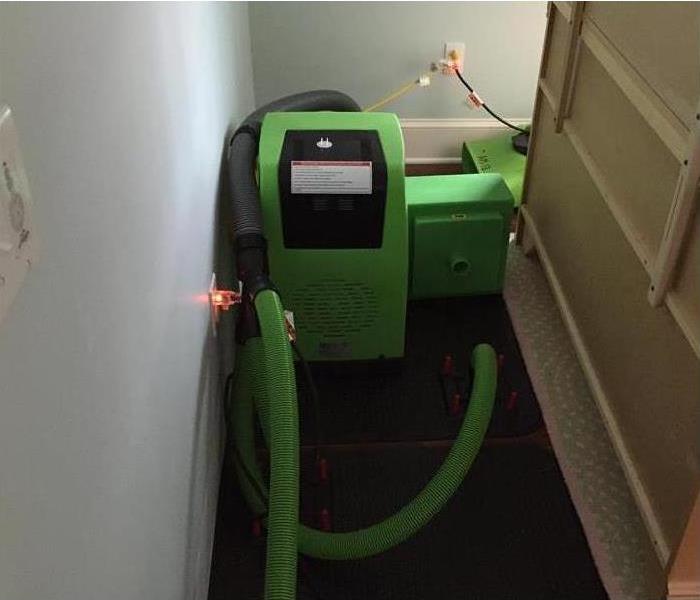 Here is our cavity drying system to efficiently mitigate high moisture trapped within hardwood floors and wall cavities.
Here is our cavity drying system to efficiently mitigate high moisture trapped within hardwood floors and wall cavities.
Nobody ever thinks it can happen to them, but it can. Water intrusion may be more severe in commercial buildings than in a residential setting and the effects more extensive. Many commercial structures have a larger volume water entering the premises through plumbing supply lines and at a higher water pressure. The quantity of outgoing sewage is greater than a typical residence, as well. Also, commercial buildings tend to be of larger square footage than a home, so entry points for water intrusion through areas like the roof, exterior walls or windows are commensurately greater in number, as well.
Water intrusion in commercial buildings can damage high-value equipment like computers and also building services such as HVAC, lighting, elevators and security equipment. Common long-term consequences of water damage like the growth of toxic mold may be even more problematic than in a home due to the larger occupancy of a business or other commercial enterprise. When a greater number of people with a wider range of sensitivity are exposed to mold and bacteria spores, health effects may be significantly magnified, perhaps leading to an enforced closure of the facility until the situation is fully remediated.
Typical issues from water intrusion in the commercial environment include:
- Water from roof leaks penetrating through ceilings. Chronic leakage through the roof may proceed unnoticed for long periods, hidden by suspended ceiling panels or in electrical or HVAC service areas above.
- Ruptures of water supply lines typically release clean (white) water. Sewage backups or leaks in drain pipes release toxic (black) water that may be a biohazard and require evacuation of the premises.
- Flooding from external sources can result from heavy rains, storms such as hurricanes, rapid snow melt or local overflowing lakes or rivers.
- Moisture intrusion through the building envelope is typically more subtle. Vermont's humid outdoor air may be drawn in through structural cracks and gaps. Over a period, chronic dampness forms in spaces like wall voids, attics and service areas, spawning hidden mold growth that persists unseen.
For professional remediation of water intrusion in commercial buildings and to prevent secondary damages such as mold growth, contact SERVPRO of Madison County @ 256-533-5335.
Is It Safe To Enter A Building That Is Recovering From A Water Damage?
7/7/2021 (Permalink)
Many people have one question: whether or not it is safe to enter their Huntsville home after a water damage. The answer is purely situational and depends on three things, if the building is structurally sound, if there are any electrical hazards, and if entering the house can lead to injuries.
Checking to make sure your house did not sustain any structural damage in the aftermath of a water damage is key to understanding whether or not it is safe to go inside. Some ways to tell if there is structural damage in your house are uneven gaps on your windows and doors, cracks or bulging in walls and ceilings, slopping or cracking on floors, and/or shifting or loud unusual noises that could mean a possible collapse. If any of these occur don’t enter your home and immediately contact SERVPRO of Madison County. If you are unsure about the extent of damage to your house call for a free estimate.
Entering a home with electrical hazards can be extremely dangerous so it is important to make sure that entering your house after a water damage cannot cause you or others harm. If your house is still wet or there is still standing water the safest and most effective measure to take before entering your home is going to the main breaker and turning off the power. This will allow you to enter your home without risking being shocked by an electrical current. But to be safe, calling an electrician to examine the electrical components of your house will assure you a safe reentry into your home.
Slick surfaces and falling objects are some of the many things commonly found in buildings recovering from water damages that can lead to injuries. Coming into contact with some of these can lead to cuts, bruises, and broken bones. If you are entering a water-damaged building take caution and wear a hard hat, eye goggles, rubber boots, and a facemask. It is also advised that you do not bring children into a building recovering from a water damage. Taking the precaution will help maintain safety and get rid of injuries when entering a water-damaged building?
Taking these precautions will help you assess whether it is safe to enter your Huntsville home after a water damage. If you experience a water damage in Huntsville, Al or its surrounding areas contact SERVPRO at (256) 533-5335.
Tips for Repairing your Home after a Water Loss
6/24/2021 (Permalink)
A flood is probably one of the most damaging things you can experience, either heavy rain or home water system malfunction. When a flood happens, you need to act fast; the longer you wait, the more damages there can be.
Tip 1: Safety First
Staying inside your home after a flood can be dangerous. If you can do it, turn off the fuse connections of your home. But if your home has suffered a severe flood episode, you should wait outside for an expert to come and inspect your home.
Tip 2: Call Your Insurance Company
You should call your insurance company as soon as you have a flood. Depending on the type of flood, they might need to investigate the cause of it to determine the extension of your coverage.
All insurance companies request an inspection before approving the coverage for repairs, and sometimes the process can be tedious, so the sooner you initiate it, the better.
Tip 3: Get Your Home Inspected By An Expert
Make sure you call an experienced restoration contractor to inspect your home.
The contractors will have to check the entire area and document the damages; they might need to secure weak points too temporarily. A full-service restoration contractor would be ideal, so they can also take care of removing the water, cleaning, mitigating the mold, and making repairs.
Tip 4: Clean & Dry Your Home
Proper cleaning and drying of your home will guarantee there’s no mold growth.
The company or contractor you contact might also use dehumidifiers to ensure there’s no space for more mold growth. During this phase also make sure they double-check hidden places for mold growth.
Tip 5: Doing The Repairs
A construction company or restoration contractor that specializes in flooding or natural disaster repairs is best. They will know exactly how to deal with the damages and make the restoration process faster and safe.
For the repairs, choose quality over price; for this, ask the contractor for his certifications and past experiences.
How To Prevent Water Damages
6/4/2021 (Permalink)
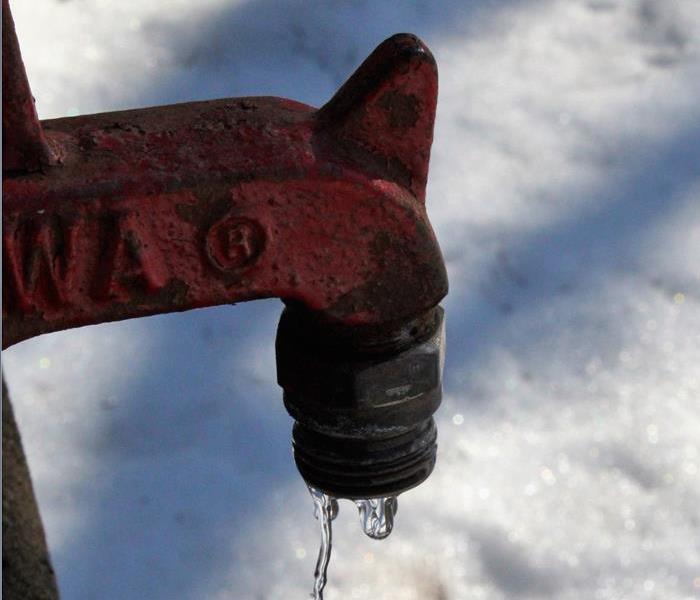 Water leaks can be dangerous for your home and potentially lead to water damages.
Water leaks can be dangerous for your home and potentially lead to water damages.
Alabama has the fourth most rainfall of any state in the U.S. falling behind only Hawaii, Louisiana, and Mississippi. Huntsville alone averages 55 inches of rain in a single year. This makes Huntsville and other cities in North Alabama a hotspot for water damages.
Even with all this rain, you can still do simple things around the house to prevent yourself from falling victim to water damages.
Clean Your Gutters
Cleaning your gutters at least twice a year can prevent standing water and overflow that damage the foundation and/or roof of your house. An alternative for having to clean your gutters is investing in products that prevent leaves and other debris from entering your gutters.
Maintain Appliances
As your appliance’s age goes up so does the likelihood of their pipes beginning to leak. The hoses in your appliances such as refrigerators, dishwashers, and washing machines should be replaced every three to five years. Doing this helps prevent your appliance from leaking and causing water damages within your house.
Install A Water Detection Device
Water Detection Devices are devices that set off an alarm when they come into contact with moisture. They don’t stop water damages from happening but they do allow you to be more aware of issues within your house and help you address them before they become a major problem.
Keep A Close Eye On Your Water Bill
One of the best ways to tell you have a water leak is by checking your water bill. If your water bill increases dramatically without a known cause it could be due to an unnoticed water leak. By paying attention to your water bill you can save yourself money and make sure your house doesn’t get damaged.
Investigate Leaks
One of the simplest and easiest ways to prevent your house from taking major damage because of a water leak is by investigating leaks as soon as you see or notice them. This may sound simple but if the problem is ignored it can become a lot worse without you knowing.
These five simple tips can help dramatically reduce your chances of becoming a victim to a water damage even with drastic amounts of rain.
If you experience a water or storm intrusion in Huntsville, Al, or its surrounding areas we can help. Contact us at (256) 533-5335.
What is in your Water ??
5/6/2021 (Permalink)
Did you know that the water either coming into your home or from your home due to busted pipes or leaks has what we call a “category”? When it comes to handling mitigation in your home it is better to allow the professionals at SERVPRO of North and South Madison County to deal with the emergency because you have to treat the water correctly to be safe. You never know what is either in your water or what the water has passed through to create contamination.
The information below explains the main types of water damage and could help you identify the problem quickly if it ever happens to you.
Category One: Clear Water
This water is the cleanest, most non-toxic form of water damage. It is potable water, perhaps directly from the tap. It is unlikely to cause you any harm, even if you are exposed for some time. Nevertheless, even clean flooding can lead to electrical and structural faults, so it is safer for you to call in the experts for repairs. Clean water comes from things like a broken water supply line, tub or sinks overflow with no contaminants, appliance malfunctions involving water-supply lines to name a few. However, once clean water leaves the exit point, it might not remain clean after contacting other surfaces or materials. Although it is considered the "safest" of the categories, it can degrade to category 2 or 3 if left untreated.
Category Two: Gray Water
Gray water damage is a little bit more serious and requires a speedier removal process. This is because it may contain potentially unsafe levels of chemicals, microorganisms, or dirt. Examples of Cat 2 water include, but are not limited to: overflow from dishwashers or washing machines; overflows from toilet bowls with urine; seepage due to hydrostatic pressure and broken aquariums.
If left untreated, it can quickly degrade into category 3.
Category Three: Black Water
Cat 3 water is grossly contaminated and can contain pathogenic, toxigenic or other harmful agents. Cat 3 water can include, but are not limited to: sewage; toilet backflows from beyond the trap; flooding from seawater, rivers or streams, ground surface water, or other contaminated water entering the indoor environment.
The team at SERVPRO of North and South Madison County is skilled in the safe handling of the different categories through training and protective clothing to eliminate the risk of sickness.
The Differences Between Commercial and Residential Water Damage
2/19/2021 (Permalink)
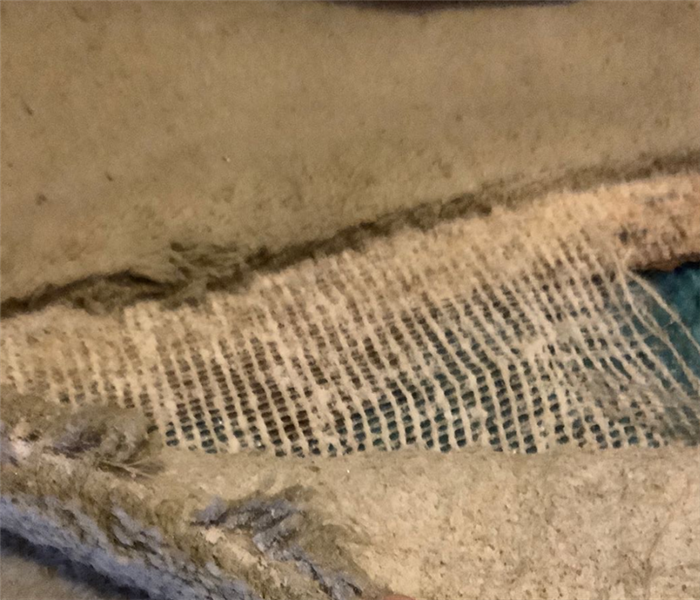 Carpet delamination damage from water saturation.
Carpet delamination damage from water saturation.
There is a difference between residences and businesses when it comes to water damage. Usually it is the type of carpet that gets wet that makes the most difference. In someone’s home, water damages usually have carpet over padding. So, in someone’s home, for example, the carpet is soaked and the padding is completely engulfed in water in many cases, or at least extremely wet. The usual process in a residential home is to remove the carpet from the floor and remove the padding. The next step is to remove the tack strip that holds the carpet down. Lastly, you’d add an air mover to dry the carpet.
Commercial buildings, however, you’d have wet carpet that is glued down to the floor which means, in most cases, there is no padding. This can be good and bad. The bad part? Getting the bottom of the carpet that is glued to the floor to dry.
Air movers are used to blow air onto the carpet to dry it. The problem is, the air mover only dries the surface of the carpet leaving the underside open to a new score of issues. The underside of the carpet can still be wet and if left that way, can become a breeding ground for mold and bacteria. If you didn’t know, mold growth in closed quarters, whether in your home or your business can cause health effects. After a few days of a wet carpet everyone will start to notice foul odors. Those odors are the growth of bacteria and mold.
Unless you have a moisture meter to determine if the carpet is wet underneath, you have to assume that the carpet is dry by feeling the surface of the carpet. As we have just learned, that could become a liability and opportunity for employees to complain and possibly bring legal action.
The Solution:
Drying underneath the carpet and preventing mold damage and bacteria growth. Remember that mold normally (but not always) takes 36 to 72 hours to start to grow. There are molds that grow faster, but this an average time period for most molds. If you work fast you have some time to prevent a serious issue. (Just an Fyi, any wet carpet areas more than 3x3 will need a IICRC certified professional to dry properly.)
The good news is, you can usually dry underneath the carpet without taking the carpet up, through osmosis! Drying the surface of the carpet will eventually "suck" the moisture from the bottom of the carpet to the top. By continuing to dry the carpet for about 3 days you will have successfully greatly lowered your chances of mold and bacteria growth underneath your carpet.
If you have a residential or commercial water damage, get the professionals at SERVPRO of South Madison County to come and assist in restoring your floors to their former glory!
Do I have a leaky pipe?
2/4/2021 (Permalink)
 Stope Leaky Pipes Before a Disaster Occurs!
Stope Leaky Pipes Before a Disaster Occurs!
A leaking pipe at your home or business in Huntsville, AL, can be caused by a number of things. Frozen water inside supply lines, poor insulation, rust, or visible moisture are all signs that a supply line could be leaking. Frozen water inside a supply line or rust may lead to a sudden burst of the line itself. Often, there are signs that you can see that indicate a problem before the pipe actually bursts, and you have a major water cleanup job on hand. Keep an eye out to catch a leaking supply line before it becomes a problem.
1. Abnormally High Water Bills
If you haven't significantly increased your company's water usage, then a sudden increase in your water bills may indicate a leak. A supply line leaking will drive your water cost up because there is always water flowing. Have a plumber come for an inspection to control the water costs and resolve problems that could lead to a major pipe burst cleanup job.
2. Changes in Water Pressure
A pipe that is frozen or leaking will not be able to provide the same amount of water pressure as a problem-free pipe. You may notice that sinks and toilets are slow to drain or that they clog easily. This could be due to decreased water pressure caused by a leaking supply line. The increased pressure of the pipes trying to do their job could lead to a pipe bursting.
3. Discovery of Water Damage
Standing water is usually a strong indicator that you have a problem. Pipe burst cleanup should be handled by a professional water restoration company. There are different categories of water that can come from a burst pipe, and you want to be careful when dealing with potentially contaminated water. Watermarks on ceilings and walls are other indicators that you have a leak. A professional team can use this information to evaluate the extent of the problem and help you restore your business.
Pipe burst cleanup is usually extensive and expensive, so keep an eye out for signs of leaking pipes. The sooner you can catch the problem, the better off your business will be.
Restoring Belongings After Flood Damage
9/3/2020 (Permalink)
When a flood damages your home, it can also effect personal property such as books, photos and documents. We know that these belongings may be important to you and we want to do everything we can to help restore them.
It is necessary to understand that water-damaged books and documents are not fully recoverable. This means they will not reach pre-damage condition, as some damage will always exist. Time is of the essence though. The faster the restoring process gets underway, the better each book or document will look after restoration.
Our SERVPRO® of South Madison County technicians use the vacuum freeze-drying method. Vacuum freeze drying is the only method approved by the National Archives and Records Administration and also the General Services Administration. This process involves freezing an item containing moisture and then it is dried using vacuums and pressures to achieve sublimation. In order to prevent further damage it is important that your water damaged documents be frozen as quickly as possible.
Freezer storage facilities at SERVPRO® Corporate give us the ability to store your paper products. We maintain a log of items moved into storage and where they are within the facility so we can return them easily after restorations are complete.
SERVPRO® of South Madison County is dedicated to assisting you with restoring these personal property items. Call us if you have a water damage at 256-533-5335.
Interesting Facts About Water, In Relation to Water Damage
7/13/2020 (Permalink)
Water. We don’t spend much time thinking about it on a day to day basis...until it causes some major damage. There are a ton of interesting facts regarding water in general, but we want to share some that can be linked to water damage. All of the facts below are courtesy of https://www.espwaterproducts.com/water-facts/.
A small drip from a faucet can waste as much as 34 gallons of water a day.
Every day, six billion gallons of treated water is lost due to leaking pipes in the U.S.
There are an estimated 240,000 water main breaks per year in the U.S., wasting over two trillion gallons of treated drinking water.
More than half of the water used in a home is used in the bathroom.
The aging infrastructure in the U.S. causes a water main break every two minutes.
As you can see, even though we don’t think about water all the time, it has a major impact on society as a whole.
If you ever find that water has impacted your life in a damaging way, SERVPRO® of South Madison County is here 24/7 365. Call us at 256-533-5335.
Toilet Leak Tip from a Plumber
6/25/2020 (Permalink)
Toilets can do some serious damage when they leak. One reason is due to the leak going undetected for some time. When this happens, the leak can soak through the sub floor and if on the second level can leak through the ceiling and wreak havoc.
When remodeling one of our bathrooms, a plumber gave us a tip to help in early detection of a toilet leak. His suggestion...when caulking the toilet base at the floor, leave a small section un-caulked. You can do this at the back of the base, closest to the wall to make it less noticeable. If/when there is a leak, the water will have an area to escape to, essentially ‘showing’ itself.
When you do detect a toilet leak, SERVPRO® of South Madison County is here to assist in any water damage that has occurred. Call us at 256-533-5335 anytime.
Top 5 Appliances & Fixtures Most Likely to Cause Water Damage
5/20/2020 (Permalink)
They were invented to make our lives easier and save time. Because of them, we can focus on more enjoyable things. We don’t know about you, but washing dishes and clothes by hand or boiling water for a hot bath are not things we really want to spend our time doing. While appliances and fixtures can make life a breeze, they can also be the culprits of some serious water damage. Still, the pros outweigh the cons by a long shot. It never hurts to be aware though, so here are the top 5 appliances and fixtures most likely to cause water damage:
Toilet
Water Heater
Air Conditioner
Washing Machine
Refrigerator
Dishwasher
One thing to keep in mind...appliances/fixtures on the upper level of a multi-level home can cause the most damage due to water leaking from the top floor down into the lower floor.
If you suffer water damage from any of these, do not hesitate to call SERVPRO® of South Madison County at 256-533-5335 for emergency services. We are available 24/7 365 days a year.
How Professionals Restore Water Damaged Subfloors in Huntsville Homes
2/17/2020 (Permalink)
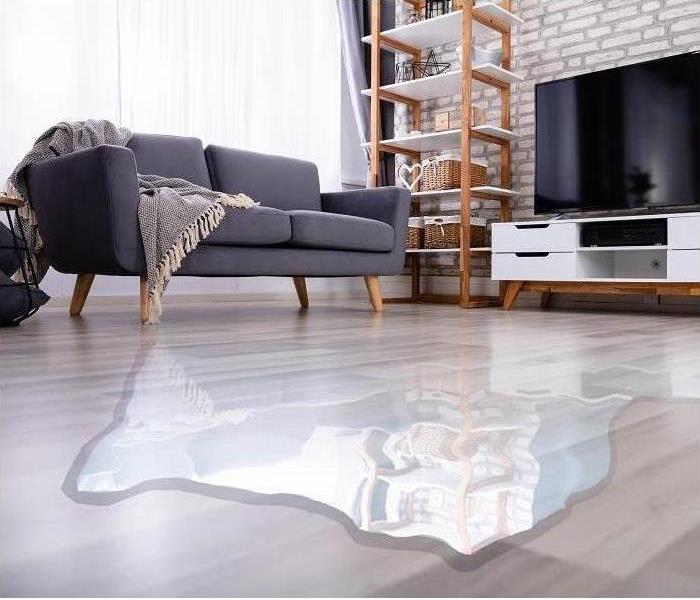 Water can quickly damage the subfloor. SERVPRO is equipped and trained to restore your water damaged floor.
Water can quickly damage the subfloor. SERVPRO is equipped and trained to restore your water damaged floor.
Flood Damage and Subfloor Restoration for Huntsville Residents
Bringing your home back to its preloss condition after flooding can be a challenging task for even the most enthusiastic home repair people. Floodwaters spread quickly from the source and can often seep into the wall spaces or through the floor, where it begins to saturate the subfloor below. Subfloor damages as a result of flooding can result in significant losses for a homeowner. Once moisture saturates the subfloor, there is a high chance of rot, mold growth, or weakening of the structure itself.
Since harm to your subfloor often goes unnoticed, it can impact homeowners several months after flood damage to their Huntsville home. At SERVPRO, we find that a great many of our mold remediation jobs are caused by a flood or water incident at the property several months before. When your property is full of floodwater, understandably, you prioritize removing moisture and drying the property. However, without conducting a full inspection of the subfloor, you could be a victim of significant flood-related losses.
Assessing your subfloor can be difficult as various fittings need removal to gain access. SERVPRO technicians use moisture sensors to gain an accurate picture of subfloor water damage without removing materials. Moisture sensors use sharp probes to push through carpets and tell a technician whether or not standing water has migrated downward. Should a moisture sensor return a positive reading for moisture, your technician may need to remove carpet or floorboards to dry the subfloor.
Subfloor pads are often the first thing to go when water migrates into the subfloor. These large porous materials absorb water quickly and can break apart when wet. SERVPRO technicians can remove the pad, cut it into smaller pieces, and place it into a waste disposal bag. The removal of the pad allows us to gain direct access to the subfloor, where we can deploy standing extractors to remove any excess from the affected area. In some cases, we may deploy desiccant dehumidifiers to draw moisture from a subfloor with high levels of saturation. Once dry, we can replace the existing subfloor pad with a new one at a low-cost.
Professional restoration services can protect your home from sustaining damages further down the line. Contact SERVPRO of South Madison County at (256) 533-5335.
Commercial Water Damage
2/14/2020 (Permalink)
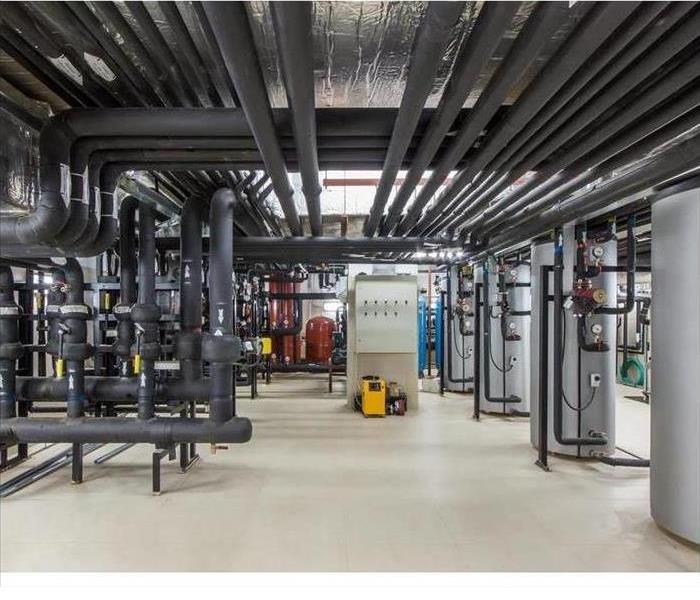 Building Plumbing System in Huntsville, AL
Building Plumbing System in Huntsville, AL
Should I Update My Plumbing System?
If your Huntsville, AL commercial property was built or repiped sometime between 1978 and 1996, there’s a good chance that it has polybutylene pipes. What once was hailed as a great new plumbing technology eventually turned into a bunch of burst pipes and flooded properties. Then, polyvinyl chloride (PVC) was introduced. So, which is the best decision, keeping the old pipe system and risking a disaster or paying to repipe the building with PVC? The old pipes:
1. Degrade
What they didn’t realize about the material of this type of pipe is that it degrades over time. Water treatment chemicals, such as chlorine, can break down the material making it brittle. Over time, mini-fractures will form in the pipe, eventually causing it to rupture under the water’s force. Unfortunately, there’s no way to detect a problem with the pipe since the deterioration starts from within the pipe.
2. Affect the Water
Brittle, degrading pipes can affect the quality of the water. Chemicals can leach into the water.
3. Aren’t Repairable
There’s no way to repair a damaged polybutylene pipe since it degrades from the inside out. Replacement is your only option to protect your building.
4. Aren't Up to Code
Building codes in the United States and Canada no longer recognize these pipes. If you want your building to be up to code, you’ll have to get your building repiped with PVC.
5. Won’t Be Covered by Insurance
More than likely your insurance won’t cover your building if it has these old pipes. At the very least your insurance premiums may be a lot higher than they would be with newer pipes.
6. Lower the Building’s Value
Few will want to buy a building that’s not up to code. If they do, it’s going to probably be for a lot less than your building is worth. Getting your building up to code will make it much more appealing to potential buyers when it’s time to sell.
Getting new plumbing for your building could get expensive. If your building sustains water damage due to degraded polybutylene pipes, restoration professionals can return it to its preloss condition.
Water Damage in your South Madison Home
10/18/2019 (Permalink)
Sometimes the source of water is easy to find. However, sometimes the issue is a pipe in the wall or a slow leak under the sink. Some signs of water damage are: standing water, discoloration, musty odors, and in some cases mold. Knowing where the water is will assist you in where to shut off the water. Some homes have a water shut-off valve in the home and most homes have a main shut-off valve commonly by the street. It is important that whatever the source of the water is repaired or replaced by a professional.
While we cannot plan for when a water loss will happen we can control what happens after. Water will take the path of least resistance. Shut off the source of water from its source or from the main to your home. Call your insurance company and a water restoration company such as us so that we can inspect the damage and come up with and execute a plan to dry your home. It is always better to have a restoration company come out as soon as possible to start the drying process.
Remember, minimizing the damage will not stop the damage. Materials such as wood and drywall will absorb damage. Additionally, avoiding secondary damages depend on the source of water as well as time taken to remove said water from the affected materials. Given that we are able to get to your home and start work promptly our goal is to minimize any damage and necessary demolition in your home.
Water Restoration , Mold Mitigation
7/13/2019 (Permalink)
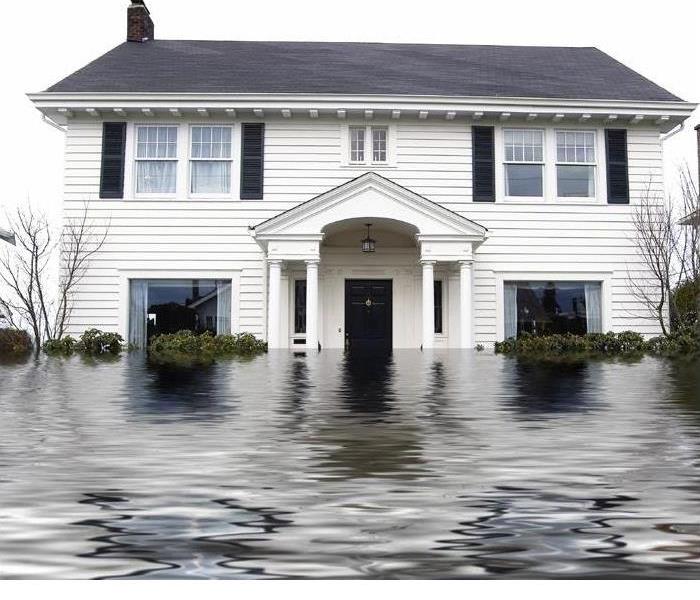 Flood Waters can cause more than just property damage
Flood Waters can cause more than just property damage
Flood Clean-Up: Avoid Indoor Air Problems
Introduction
During a flood cleanup, the indoor air quality in your home or office may appear to be the least of your problems. However, failure to remove contaminated materials and to reduce moisture and humidity can present serious long-term health risks. Standing water and wet materials are a breeding ground for microorganisms, such as viruses, bacteria, and mold. They can cause disease, trigger allergic reactions, and continue to damage materials long after the flood.
This page discusses problems caused by microbial growth, as well as other potential effects of flooding, on long-term indoor air quality and the steps you can take to lessen these effects. Although the information contained here emphasizes residential flood cleanup, it is also applicable to other types of buildings.
Prepare for Clean-up
Obtain a copy of the free booklet, Repairing Your Flooded Home, from the Federal Emerge Management Agency (FEMA) or your local chapter of the American Red Cross (see listings at the end of this fact sheet). Read that booklet carefully before cleanup because it discusses flood safety issues and can save your life. The booklet also contains detailed information on proper methods for cleaning up your home.
This fact sheet provides additional information, not covered in the FEMA/American Red Cross booklet, on indoor air quality concerns related to flooding. Many of the methods used for general cleanup, as detailed in the booklet, are the same as those used to avoid problems with indoor air quality. For brevity, we have not provided detail on the general methods used for cleanup here. This fact sheet is intended to be used in conjunction with the FEMA) American Red Cross booklet.
Avoid Problems from Microbial Growth:
Remove Standing Water
Standing water is a breeding ground for microorganisms, which can become airborne and be inhaled. Where floodwater contains sewage or decaying animal carcass infectious disease is of concern. Even when flooding due to rainwater, the growth of microorganisms can cause allergic reactions in sensitive individuals. For these health reasons, and to lessen structural damage, all standing water should be removed as quickly as possible.
Dry Out Your Home
Excess moisture in the home is an indoor air quality concern for three reasons:
Microorganisms brought into the home during flooding may present a health hazard. These organisms can penetrate deep into soaked, porous materials and later be released into air or water. Coming in contact with air or water that contains these organisms can make you sick.
- High humidity and moist materials provide ideal environments for the excessive growth of microorganisms that are always present in the home. This may result in additional health concerns such as allergic reactions.
- Long term increases in humidity in the home can also foster the growth of dust mites. Dust mites are a major cause of allergic reactions and asthma.
See Step 4 of the American Red Cross/FEMA booklet, Repairing Your Flooded Home, on steps that should be taken to open up and dry out ceilings, walls, and floors in the home.
Be patient. The drying out process could take several weeks, and growth of microorganisms will continue as long as humidity is high. If the house is not properly, a musty odor signifying growth of microorganisms, can remain long after the flood.
Remove Wet Towels
It can be difficult to throw away items in a home, particularly those with sentimental value. However, keeping certain items that were soaked by water may be unhealthy. Some materials tend to absorb and keep water more than others. As a general rule: Materials that are wet and cannot be thoroughly cleaned and dried should be discarded, as they can remain a source of microbial growth.
Information on the types of water-damaged materials that should be discarded are provided in Step 4 of the American Red Cross/FEMA booklet, Repairing Your Flooded Home. The booklet suggests that you may be able to dry out and save certain building materials (for example, wallboard, fiberglass insulation, and wall-to-wall carpeting that were soaked only with clean rainwater and plaster). You may, however, want to consider removing arid replacing them to avoid indoor air quality problems. Because they take a long time to dry, they may be a source of microbial growth.
In addition, fiberboard, fibrous insulation, and disposable filters should be replaced, if they are present in your heating and air conditioning system and contacted water. (If a fitter was designed to be cleaned with water and was in contact with clean rainwater only, ensure that it is thoroughly cleaned before reinstalling.)
Avoid Problems from the Use of Cleaners and Disinfectants
The cleanup process involves thorough washing and disinfecting of the walls, floors, closets, shelves, and contents of the house. In most cases, common household cleaning products and disinfectants are used for this task. FEMA also suggests the use of disinfectants and sanitizers on the duct work for the heating and air conditioning system, if it has been flooded.
Disinfectants and sanitizers contain toxic substances. The ability of chemicals in other household products used for cleaning to cause health effects varies greatly, from those with no known health effect to those that are highly toxic. Read and follow label instructions carefully, and provide fresh air by opening windows and doors. If it is safe for you to use electricity and the home is dry, use fans both during and after the use of disinfecting, cleaning and sanitizing products.
Be careful about mixing household cleaners and disinfectants together. Check labels for cautions on this. Mixing certain types of products can produce toxic fumes and result in injury and even death.
Avoid Carbon Monoxide Poisoning
Carbon monoxide is a colorless, odorless gas that can be lethal at high levels. Carbon monoxide levels can build up rapidly if certain types of combustion devices (for example, gasoline-powered generators, camp stoves and lanterns, or charcoal-burning devices) are used indoors. Do not use combustion devices designed for outdoor use indoors.
Avoid Problems from Airborne Asbestos and Lead Dust
Elevated concentrations of airborne asbestos can occur if asbestos-containing materials present in the home are disturbed. Airborne asbestos can cause lung cancer and mesothelioma, a cancer of the chest and abdominal linings. If you know or suspect that your home contains asbestos, contact the EPA TSCA Assistance Information Service at (404) 562-9143 for information on steps you should take to avoid exposure.
Lead is a highly toxic metal which produces a range of adverse health effects, particularly in young children. Disturbance or removal of materials containing lead-based paint may result in elevated concentration of lead dust in the air, if you know or suspect that your home contains lead-based paint, contact the EPA lead hotline at 1-800-424-LEAD for information steps you should take to avoid exposure.
Additional Information
- U.S. Environmental Protection Agency Regional 4 Phone: 1-800-241-1754 or (404) 562-9900
- FEMA Public Affairs Phone: (202) 646-4600
- American Red Cross - Publication Number ARC 4477
https://www.alabamapublichealth.gov/index.html
Bathroom Remodel
7/9/2019 (Permalink)
https://www.houzz.com/magazine/10-things-to-consider-before-remodeling-your-bathroom-stsetivw-vs~59865028
Be Cautious During Flooding in Madison County
6/21/2019 (Permalink)
Failing to evacuate flooded areas, entering flood waters, or remaining after a flood has passed can result in injury or death. Flooding is a temporary overflow of water onto land that is normally dry. Floods are the most common natural disaster in the United States. Floods may:
Result from rain, snow, coastal storms, storm surges, and overflows of dams and other water systems.
Develop slowly or quickly – Flash floods can come with no warning.
Cause outages, disrupt transportation, damage buildings, and create landslides.
IF YOU ARE UNDER A FLOOD WARNING, FIND SAFE SHELTER RIGHT AWAY
Do not walk, swim, or drive through flood waters. Turn Around, Don’t Drown!
Stay off of bridges over fast-moving water.
Determine how best to protect yourself based on the type of flooding.
Tips to Handle Mold After Water Damage
5/28/2019 (Permalink)
Mold is often a problem after a water damage. Many homeowners try to handle water damage cleanup themselves and unseen damage leaves moisture that later causes mold to grow.
If you had a water damage recently and you now smell a musty odor or have visible mold, here are some tips from the Federal Emergency Management Agency (FEMA) to help control mold problems:
- The source of mold is moisture; therefore fix all leaks in pipes and in any damp area around tubs and sinks.
- Rebuild, or retrofit, with water-resistant building materials such as tile, stone, deep-sealed concrete, galvanized or stainless steel hardware, indoor/outdoor carpeting, waterproof wallboard and water-resistant glues.
- Prevent seepage of water from outdoors into your house. It is important to have rainwater from gutters or roof drains away from the structure. Ground around the house should slope away to keep basements and crawl spaces dry.
- Cover dirt in crawl spaces with plastic to prevent moisture from coming up from the ground. Ventilate the area as much as possible.
- Clean fabrics such as curtains and upholstery often to keep them dry, because soil promotes mold growth.
- Consider having ductwork cleaned and inspected professionally or replaced if you suspect mold exists on the inside surface of the duct or if duct insulation has been wet.
- Reduce the moisture in the air with dehumidifiers, fans and open windows or air conditioners.
- Do not use fans or vacuum cleaners if mold already exists, especially in hot weather. A fan or vacuum cleaner will spread the mold spores.
- In moisture-prone areas, choose carpets of man-made fibers.
- Reduce potential for condensation on cold surfaces by insulating.
- Routinely check potential problem spots.
For more information, visit www.fema.gov/removing-mold-your-home.
Are You Prepared for Spring Flooding?
2/13/2019 (Permalink)
While spring brings the promise of warm weather and longer days, it also brings a variety of conditions that can include heavy rains and severe weather, which can increase your flood risk. During the rainy season, we are at high risk for flash flooding, which can occur rapidly within a few minutes or hours of excessive rainfall.
As one of the most common hazards in the United States, it's important we prepare for the potential disaster that flooding can cause. Even if you are located in a low risk flood zone remember that anywhere it rains, it can flood. Just because you haven't experienced a flood in the past, doesn't mean you won't in the future.
In order to help prepare you for the possibility of a flood, I offer the following tips:
- Build an emergency kit and make a family communications plan
- Elevate the furnace, water heater and electric panel in your home if you live in an area that has a high flood risk
- Install check-valves to prevent flood water from backing up into the drains of your facility
- Seal basement walls and floors with waterproofing compounds to prevent seepage through cracks
- Always keep your gutters and downspouts clean to allow water to flow freely
- Prepare a flood evacuation plan
- Know how to safely shut-off utilities
- Keep insurance and vital records in a water-proof box
- Have a portable radio to listen for important current information
The longer you wait to call, the greater the chance of mold growth and unrecoverable property. SERVPRO professionals have the expertise to prevent or mitigate the devastating effects of water damage.
What To Do When Your Water Heater Leaks
2/12/2019 (Permalink)
Waking up is hard to do. You need to get out of your cozy bed, go wash up, get dressed and get some coffee in you before you start your day. Now think of getting out of bed, as hard as that is, walking slowly to the shower, opening the hot water, and waiting for it to run so you can hop in, and nothing happens.
Water stays cold as ice, you realize you can't hit the shower this morning, and you try to figure out what just happened. Is it the water heater? Could it be broken? Time to check it out.
As you walk downstairs you hear a low trickling noise as if a faucet is open somewhere. You keep going, and as you approach the basement, you hear it louder - there is water running somewhere over there. Question is - where? As you reach the last step, you put your foot down and immediately realize you haven't even opened your eyes properly. You're standing in a big pond, which was once your basement. No hot shower today. What now then?
First thing - close the water source. Whether it's the water heater or a pipe, make sure no more water can get in. Close the water mains and shut down any valve leading to the affected area.
Second, take care of all that water. Water spreads fast and has the power to cause lots and lots of trouble over time. If you don't have a water drain in the basement, it's time to call SERVPRO of South Madison County at 256-533-5335.
Water leaks and floods should be taken care of as fast as possible. The reason is that most homes aren't waterproof on the inside. Standing water will ruin your carpets, floors, furniture, and even get into drywall if given the opportunity. Moreover, the standing water becomes a health hazard after a while, even if they came from a clean source (also called Category 1 water damage). Another reason for you to hurry is mold and how fast mold can start to grow after your basement suffered from a water damage.
SERVPRO of South Madison County offers a 24/7 response to all your water damage requirements and needs, providing you a quick and thorough solution to your problem. We'll get your life back to normal in no time.
Basement Water Damage
10/18/2018 (Permalink)
Water damage can happen in any area of your home. However, the basement offers its own unique challenges when it comes to water damages. The most common type of water damage in the basement results from broken water pipes. The first step is to turn off the water at the main valve. You'll need to start cleaning up right away to prevent mold, mildew and bacteria from forming.
It is important that you remove rugs, furniture and other items that have gotten wet. Take them outdoors where they can completely dry in the sun. Use a heavy-duty vacuum cleaner that is made especially for water cleanup. A submersible pump is a good tool to use if you can rent one. Use a powerful fan to finish drying the room.
Choose a professional water restoration company like SERVPRO of South Madison County. These types of companies have both the experience and the equipment to remove the water in basement. Call your insurance agent to see if your policy will cover water or flood damage. Water can seep behind walls and other places where major damage can occur.
Water damage in the basement can also cause structural damage. If this is the case, it will cost a lot more money than simply hiring a restoration expert. Underground water seepage can cause the surrounding ground to shift. Evidence of this type of damage is found with cracks along the walls and ceilings.
Do not hire a carpet cleaning service to restore your basement. They may not have the experience, education or skill to complete the job correctly. Instead, look in your local yellow pages for an actual fire and water restoration company. Pay careful attention to the contract before you sign it. Most restoration companies will guarantee their work.
Floods and water emergencies can happen to any homeowner. Be prepared for this type of emergency by choosing experts before you need them. A water emergency can occur in your utility room where your washer and dryer is found. Other common places include the dishwasher, refrigerator with ice maker and pipes underneath the house.
Know where your water main cutoff is located before an emergency. Turning off the water will prevent further damage while you wait for a professional restoration company to come to your home.
SERVPRO of South Madison County professionals provide fire and water damage restoration services 24 hours/7 days a week and are ready to restore damage to your home or commercial structure.
The Trouble With DIY Restoration
10/16/2018 (Permalink)
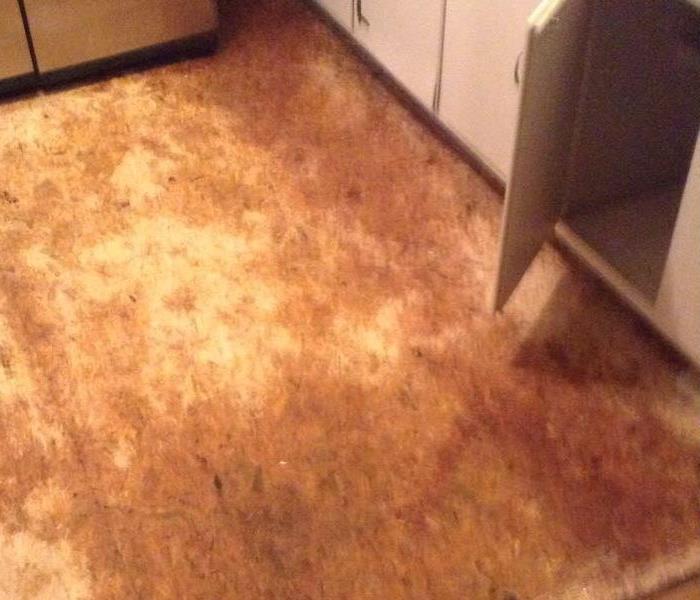 When dealing with water damage, it's often the damage that you don't see that ends up causing serious issues.
When dealing with water damage, it's often the damage that you don't see that ends up causing serious issues.
Huntsville and Madison residents take pride in their homes and properties. When disaster strikes or when you have a substantial mess to clean up, it is a common belief to roll up your sleeves and get to work to fix the problem as best as you can on your own. The trouble with DIY restoration for water incidents is that many homeowners don't get all of the problem addressed, allowing for continued damage.
While a homeowner might see a water damage situation in their Huntsville residence as little more than a reason to break out the mop and run some fans, there is much more to water damage restoration. Ensuring that the area gets thoroughly dried requires specialized equipment and detection tools. Failure to get your home below moisture standards for a house can lead to worsening conditions that pose a threat to the structure, as well as your family.
One of the reasons that you might consider professional restoration like SERVPRO provides is our ability to respond to your situation rapidly. Even in smaller scale water incidents, fast response time is critical to mitigating loss and to get to work quickly on removing the water and drying up the affected areas.
Another reason that a homeowner should think about our SERVPRO team is our industry-leading equipment, expertise, and unique training. These facts help us quickly assess the full scope of the damage that affects your home and choose the most efficient and practical approach to eliminating the moisture and preserving the construction materials that have gotten saturated by the incident.
As much as you might be among the homeowners that seek to do things for themselves when something happens to their home, situations like water damages require professionals with the right training and equipment to ensure that the job gets done adequately. Our SERVPRO of South Madison County water damage technicians are available 24/7 for any need you might have by calling (256) 533-5335.
Restoring Your Belongings After A Water Leak
6/20/2018 (Permalink)
Water damage in your home can be devastating, whether it comes from leaking pipes or backed-up drains or toilets. While there may be nothing you can do to prevent your items from becoming waterlogged in the event of an unexpected water leak, there are some things you can do to restore your belongings after water damage occurs. Here are a few ways you can clean up various items in your Huntsville/Madison County home.
1. Separate Items
Before you officially begin the cleanup process, separate your items into those that are porous and nonporous. Porous materials may include wood, paper, rugs and other types of fabric. Generally, these are more likely to harbor mold and bacteria from broken pipe water, so it’s important to clean them quickly. Nonporous items are usually much easier to clean, since they don’t absorb water and are less likely to harbor bacteria and mold.
2. Dry-Clean Non-Porous Items
Dry cleaning may be appropriate when removing light water residue from non-porous items in your home. Items can also be dry cleaned before floor restoration professionals come in and thoroughly clean your items.
3. Air-Dry When Appropriate
If you’re not dealing with hazardous water, such as sewage, it may be appropriate to gently air-dry most of your belongings. If possible, do so indoors unless the weather outdoors is ideal. You can increase the air flow inside your home with the use of open windows, air conditioners and fans.
4. Toss Dangerous Items
Depending on the nature of floodwater in home settings, it may be dangerous to keep saturated items. If there is a high likelihood of the floodwater containing harmful bacteria, it may be best to throw away contaminated objects. In other cases, professionals may be able to safely clean and salvage some of your valuables.
While you may be able to clean some of your belongings that water has damaged in your home, safety should always be your top priority whether you’re dealing with a broken pipe or a sewer backup. For help with dry-cleaning or salvaging contaminated items, it’s best to wait for professional help to arrive. Visit SERVPRO of South Madison County for more information on water damage.
Top Reasons Toilets Leak When Flushed
6/18/2018 (Permalink)
Leaking water is never ideal. It can waste your money and even cause damage to your Huntsville home. If you have a leaking toilet, you may be at your wits end. Why is it happening and how can you stop it?
Knowing the why can help you better understand how to fix the problem. As you try to investigate your bathroom leak, consider these possibilities:
Damaged Wax Ring: The wax ring at the base of the toilet may dry out or get damaged in another way. This makes the seal imperfect and can lead to leaks. If this is the culprit, you'll notice the water coming from the base of the toilet.
Loose Tank: Over time, the tank of your toilet may loosen due to use. Tanks have to fit tightly onto the seat to stop leaks from taking place. If the tank is the issue, you may notice water seeping out at the base of the tank.
Broken Closet Flange: The closet flange provides a mount for the toilet on the floor. If this part is bent or damaged, it could lead to a leaking toilet. Fixing this piece requires you to either replace the whole flange or fill in the missing piece.
Loose Closet Bolts: The closet bolts work to hold the toilet to the ground. If they get loosened over time, you may notice water pooling at the base of the toilet every time you flush. You may be able to fix this problem by simply tightening the bolts. However, you need to be careful not to over-tighten, as this can lead to cracks.
Poor Installation: Finally, if the toilet was not installed correctly to begin with, you may have leaking problems from day one. The only way to fix this issue is to try to reinstall the toilet. You may need a new wax seal and flange anyway.
Because a leaking toilet can lead to major water damage, you may not want to try to fix the problem on your own. Turning to a professional water damage specialist can help you fix the problem quickly.
Handling A Sewage Backup After Heavy Rains
5/29/2018 (Permalink)
Spring storms can be really stressful for residential and commercial building owners in Huntsville. You have to worry about hail, wind and water damage whenever a storm is predicted for your area. Even when a storm is forecasted, you never know exactly what's going to happen. Sometimes, the storms may leave your building unaffected, and other times, you're left dealing with lots of damage. For example, your area could be under threat of heavy rains, but did you know that could put you at risk for a sewer backup?
Overwhelming Amounts of Water
Heavy rainfall can leave systems waterlogged, and the city sewer system is no different. During heavy downpours, sewer systems can take on too much water. This causes the sewer water to back up into commercial buildings and sometimes homes.
Downpours aren't the only potential cause of a sewer backup. This issue can also be caused by the following situations:
* Tree roots grow into pipes.
* Broken pipes don't allow sewage to leave.
* Grease or other waste creates a plug.
* Vandals drop large items into manhole covers.
No matter why sewage is coming into your building, you need to react quickly.
Creating Black Water
When flooding is combined with sewage, your building is now full of contaminated water. This particular variety of contaminated water is often referred to as black water because it could contain fecal matter, microbes and harsh chemicals. Because this water can be highly unsanitary, you need to get the flooding taken care of as quickly as possible. Not only could you be dealing with normal flooding issues, but you may add other problems to the mix as well.
If you ever have to deal with black water, it's a good idea to bring in trained water damage restoration experts as soon as possible. When there is a sewer backup in your building, it's nice to know who you can turn to for fast, reliable help.
Call SERVPRO Today – We’re Ready To Help 256-533-5335
Where’s The Water Shut-Off Valve?
2/14/2018 (Permalink)
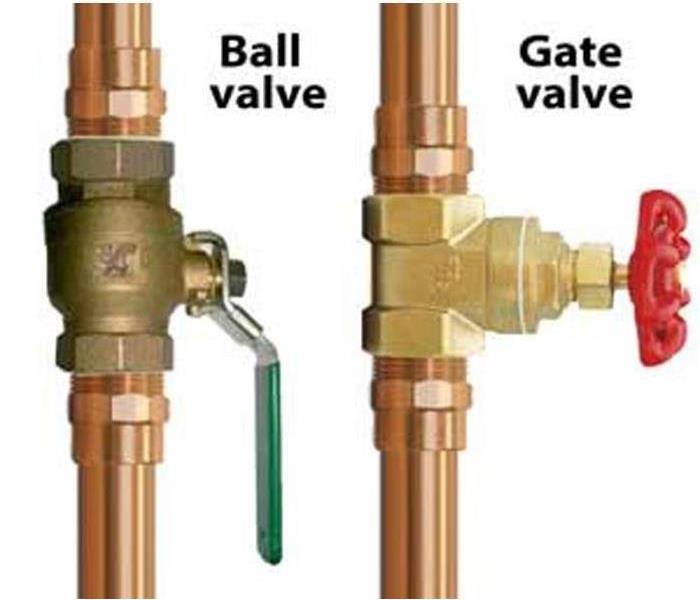 Minimize the extent of water damage by knowing how to shut off your water during a water emergency.
Minimize the extent of water damage by knowing how to shut off your water during a water emergency.
In an emergency, you may have to shut off the water to your home. For example, freezing or thawing may cause a water pipe to break. Water pipe breaks are also common with most types of natural disasters (winter storms, hurricanes, tornadoes, and more). Take some time to locate your shut-off valve before an emergency strikes so that you will be better prepared to act quickly if needed.
Where’s The Water Shut-Off Valve?
1. Look for the water shut-off valve where the water line enters your house. If you still have a copy of the home inspection report from the purchase of your home, the location of the shut-off valve may be included in the plumbing section of the report. In most homes in Huntsville, the water shut-off valve should be just inside the house where the water line enters through your home’s foundation or exterior wall.
2. Often the water shut-off valve is a quarter-turn ball valve. If that’s what you have, turn the valve a quarter of a turn until it’s perpendicular to the water pipe. Or your home may have a round handle that you turn clockwise until you can’t turn it anymore. Don’t have a master shut-off valve in your home? Have one installed by a plumber.
If You Have Water Damage Call SERVPRO Of South Madison County at (256) 533-5335
3. Another water shut-off option is closing the municipal water meter shut-off valve. This valve, if you have municipal water, typically is in your front or side yard. Look for a round metal lid or box close to your property line. It’s often 24 to 48 inches from the curb or fence line.
Don’t reach into the meter box until you inspect the area for debris and rodents. You may want to wear gloves. Once inside the municipal water meter box, you’ll need pliers or a specialty tool to turn the valve. Turn it until it’s perpendicular to the water pipe.
Shut-Off Valves For Single Rooms
Sometimes you only need to shut off the water to one room. Most newer houses have shut-off valves at every sink and toilet. Your water heater may have several shut-off valves. If your issue is one leaking sink, just shut off water to that sink. If you know the water heater is leaking, just shut the valves to it off.
If you have a young relative who has recently moved out on their own for the first time, share these tips with them. Landlords may also want to make sure that all of their tenants are aware of the location of the shut-off valve.
Drying Out Your Bedroom Carpet After Water Damage In Your Huntsville Home
2/13/2018 (Permalink)
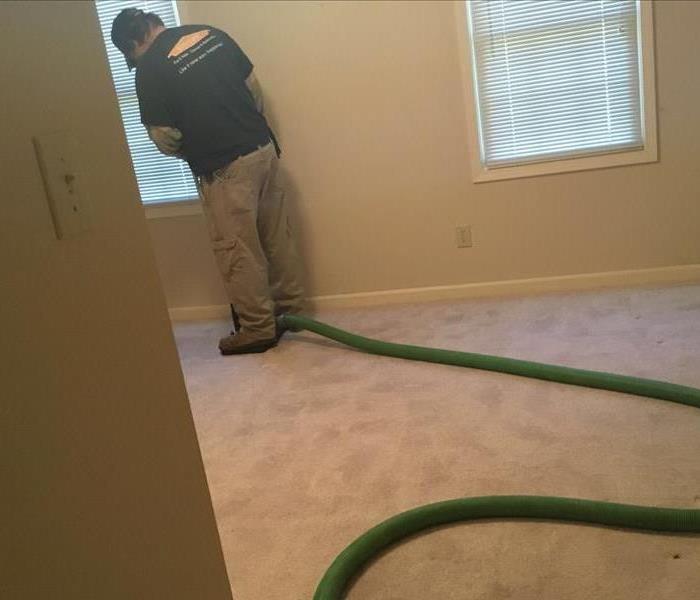 One of our technicians uses weighted extraction to remove water from the carpet of a Huntsville home.
One of our technicians uses weighted extraction to remove water from the carpet of a Huntsville home.
Rely on SERVPRO for Water Extraction from Carpets
Water damage can happen in your bedroom at any time. All it takes is a leak, a damaged pipe or even extreme weather. A wet carpet is frustrating and you want to get it dried out as quickly as possible. You might be worried about whether your carpet needs to be replaced. That is why we recommend you call SERVPRO at once. We can begin drying your carpet quickly to prevent further damage.
It is understandable to be concerned that water damage in your Huntsville home means disruption for you and your family. However, in some cases, it is possible for our IICRC-certified technicians to dry out your bedroom carpet while it is still in place. Our experts thoroughly examine your carpet and the extent of the harm to determine whether in place drying is a practical option. It may be necessary to remove your bed, but smaller furniture items such as a chest or a chair can simply be moved from place to place within the room until water extraction is complete.
The first step is to extract any standing water. We train our technicians to use the right type of extraction tools to extract the maximum amount of water with the minimum amount of damage to your carpet.
In place, extraction may begin with a wand tool to prevent water migration. However, the most useful piece of gear is a weighted extraction tool, which uses the body weight of one of our technicians standing on it for maximum water removal. SERVPRO understands that drying carpet without removing it means a longer and more thorough extraction process for best results.
Do not worry if your bedroom carpet is wet – it may be possible to save it. Give SERVPRO of South Madison County a call at (256) 533-5335 to find out.
Water Damage Statistics
10/19/2017 (Permalink)
When you consider the statistics, it becomes clear just how common a problem water damage can be. According to insurance industry research,
- 14,000 people in the US experience a water damage emergency at home or work each day
- 98% of basements in the US will suffer from some type of water damage during their lifetime.
- 37% of U.S. homeowners claim to have experienced water damage
Water leaks cause incredible amounts of damage and waste.
- Water leaks from homes in the US can exceed 1 trillion gallons of water in a year.
- Ten percent of homes have leaks that waste at least 90 gallons of water a day.
- A continuously running toilet can waste over 200 gallons of water per day, and
- A 1/8 inch crack in a pipe can spill 250 gallons of water in a day.
- A faucet leaking at a rate of 1 drop per second can waste over 3,000 gallons of water in a year.
Water Damage Ten Times More Likely Than Fire
10/17/2017 (Permalink)
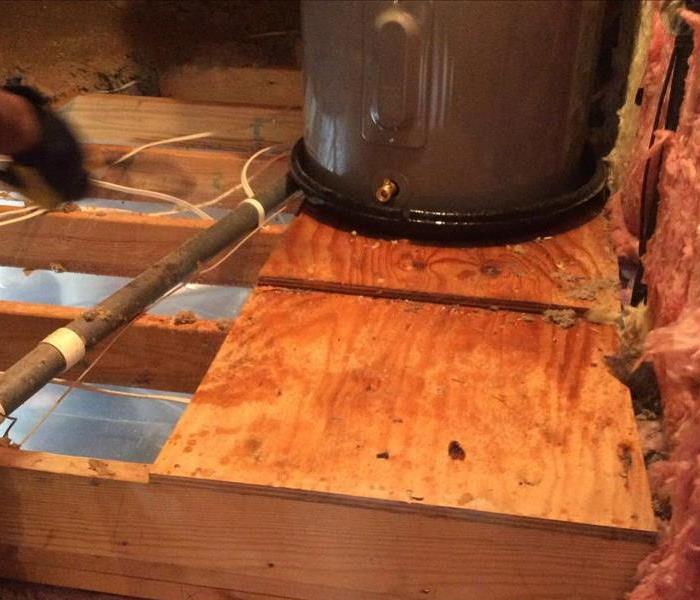 Water damage can happen to anyone.
Water damage can happen to anyone.
Most homeowners worry about experiencing a fire. Few of us worry about having a water damage in our home. A study of claims data from a major insurance company shows that your home is 10 times more likely to be damaged by water than fire.
Fortunately, much of this water-related damage can be prevented and taking a few simple home maintenance steps can help decrease the chances of water damage.
The following list provides preventive measures to help avoid the top four common causes of non-weather related water damage:
Leaks from washing machine hoses: Washing machine hoses should be inspected annually and replaced every five years – or immediately, if there are any signs of cracking or bulging.
Leaky plumbing around water heaters: Plumbing should be inspected annually and repaired if there are any signs of leaks or corrosion. When possible, water heaters should be installed in an area with floor drains to minimize damage if leaks should occur.
Leaks from refrigerator ice machines: Ice maker connections, usually located behind the refrigerator, should be inspected annually and hoses replaced if they appear cracked or corroded.
Clogged drain lines on air conditioning units: Air conditioning drain lines should be checked yearly.
Huntsville 24 Hour Emergency Water Damage Service
6/19/2017 (Permalink)
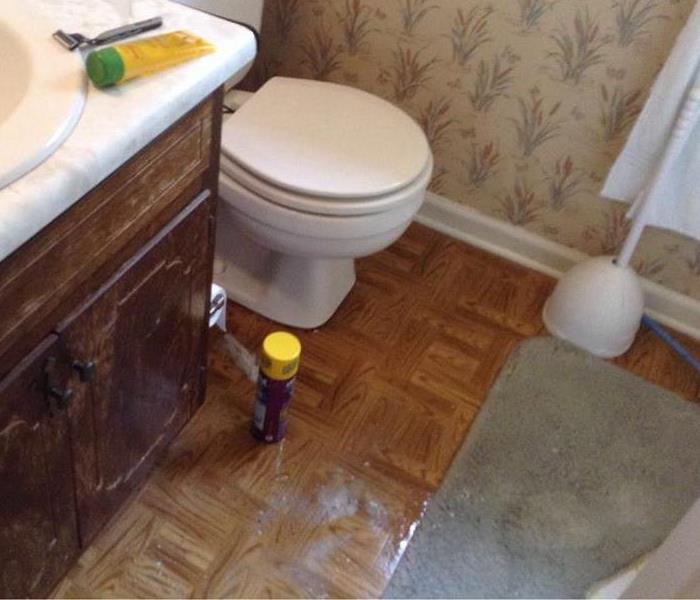 SERVPRO of South Madison County provides 24 hour fire and water damage restoration service in Huntsville
SERVPRO of South Madison County provides 24 hour fire and water damage restoration service in Huntsville
SERVPRO of South Madison County is available 24 hours a day for water emergencies, large or small. When you are dealing with water damage, immediate action is crucial. A delay of just a few hours can greatly increase the severity of the water damage.
We Answer the Phone Ready to Help
Call Today - 256-533-5335
We understand that when you call us, you may be feeling confused, stressed, and vulnerable. You need an expert to guide you through this crisis. SERVPRO of South Madison County has the specific water damage training and experience to help you through this tough time. We specialize in water damage restoration—in fact, it's the cornerstone of our business.
What to Expect
When you call, we will ask several questions regarding your water damage emergency. These questions will help us determine what equipment and resources to bring, including how many trained SERVPRO Professionals may be needed.
Our SERVPRO Representative will ask several questions:
- Your name and contact information
- Your insurance information (if applicable)
- The street address of the water-damaged home or business
- When did the flooding or water damage occur?
- What caused the water damage (if known)?
- Is there electricity available (on-site)?
About SERVPRO of South Madison County
SERVPRO of South Madison County specializes in the cleanup and restoration of residential and commercial property after a fire, smoke or water damage event. Our staff is highly trained in property damage restoration. From initial and ongoing training at SERVPRO’s corporate training facility to regular IICRC-industry certification, rest assured our staff is equipped with the knowledge to restore your property.
Huntsville Residents: We Specialize in Flooded Basement Cleanup and Restoration!
5/30/2017 (Permalink)
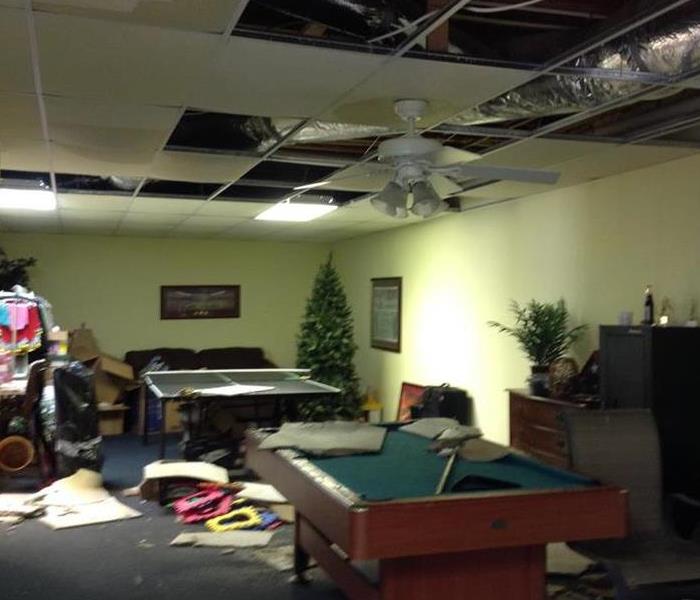 The refrigerator supply line leaked in the kitchen above and caused water damage to the basement in this Huntsville home.
The refrigerator supply line leaked in the kitchen above and caused water damage to the basement in this Huntsville home.
A basement can flood at any time, although flooding most often occurs during heavy rainfall. Basements are inherently prone to flooding because they are the lowest level of a building and are normally built partly or entirely below ground level. There are a number of reasons why your Huntsville basement could flood, including:
- A blocked or failed sewer lateral pipe
- Heavy rain causes surface water to pool around your home
- Storm sewer backup
- Sanitary sewer backup
- Foundation drainage failure
- Water supply-line break or hot-water tank failure
- And many more
Have Questions about Basement Flooding?
Call Today - 256-533-5335
If flood water is not handled quickly and properly, it can jeopardize your health and safety, and cause severe damage to your home’s structure. Remember, the longer you wait, the worse the problem will get.
The bottom line: a flooded basement can jeopardize your health, safety, and your home’s integrity. It’s worth making a call to SERVPRO of South Madison County and let our trained, professional crews handle the situation safely and correctly. We have earned the trust of hundreds of homeowners, business owners, and property professionals.
We are Flooded Basement Specialists:
- We are Available 24 hours/7 days per week
- We’re a Preferred Vendor to many National Insurance Companies
- We Bill The Insurance Directly – One Less Thing For You To Worry About
- Our Technicians are Highly-Trained in Water Restoration Techniques
- We use s500 IICRC Restoration Standards
- Advanced Inspection and Extraction Equipment
Basement Flooded? Call Us Today – We’re Ready To Help 256-533-5335
Small Water Damage Can Lead to Unseen Problems
2/16/2017 (Permalink)
Water Intrusion in One Room can Mean Water Damage in Other Rooms. Removing surface water can help prevent more extensive damage. However, water intrusion invade floors, ceilings and walls to find the lowest point in your home. Standing water from an overflowing bathtub or other water incident will search for pin hole crevices and creak in your floor and walls looking for a way a travel downward. Surface such as a woof, drywall and carpet pull water away from plain sight and into the interiors of your home.
Should a water incident occur in your home, remove excess water with mopping and blotting, remove and prop up wet upholstery cushions for even drying and place aluminum foil or wood blocks under furniture legs. These tips may prevent further damage to your home and personal belongings.
SERVPRO® of the Quad Cities Professionals can help:
Service Response Guidelines
1) Within one hour from notice of loss, a SERVPRO Professional will contact you to arrange for service
4) Within four hours of loss notification, a SERVPRO Professional will be on-site to start mitigation service.
8) Within eight business hours of on-site arrival, a verbal briefing of the scope will be communicated to the appropriate person.
** Exceptions may apply under certain conditions, such as a local catastrophic event or storm situation.
Keeping Warm in North Alabama this Winter
2/16/2017 (Permalink)
Freezing temperatures are upon us here in the Huntsville area. It is the season where we start to see a lot of water damages due to pipes that burst. People's biggest mistake that leads to more costly damages is not acting promptly and correctly.
When you have realized that a pipe has burst in your home, follow these steps to minimize your damage and in the long run, save you money.
1. Stop the Water Flow
Turn off the water main as soon as you notice something is wrong. The potential water loss from burst pipes in your house can be as much as 106 gallons; that’s two full baths an hour. Once water is off, make sure you drain the lines throughout the home
2. Locate, Inspect, and Repair the Damage
Once the damage is inspected, you will determine if this is something that you can handle on your own or if you need to bring in a plumber.
3. Call the Professional Drying Company
Once the repair is made and there will be no further damage, call professional water restoration. Areas that have been soaked in water susceptible to mold, mildew, and can cause your family unwanted illness.
The longer you wait to make these repairs the more damage will be caused. In turn, higher cost for restorations and getting your home back to normal.
Do's and Don'ts When Experiencing a Water Damage
6/17/2016 (Permalink)
Do:
- üRemove as much excess water as possible by mopping and blotting.
- ü Wipe excess water from wood furniture after removal of lamps and table top items.
- ü Remove and prop wet upholstery and pillow cushions for even drying.
- ü Place aluminum foil or wood blocks between furniture legs and wet carpeting.
- ü Turn air conditioning on for maximum drying in summer.
- ü Remove Oriental rugs or other colored rugs from wet wall-to-wall carpeting.
- ü Remove valuable paintings and art objects to a safe, dry place.
- ü Open and place luggage, in sunlight to dry, if possible.
- ü Gather loose items, toys, etc. from floors.
Don’t: - ü Leave wet fabrics in place; dry as soon as possible. Hang furs and leather goods to dry separately at room temperature.
- ü Leave books, magazines or other colored items on wet carpets or floors.
- ü Use your household vacuum to remove water.
- ü Use TVs or other household appliances while standing on wet carpets or floors, especially not on wet concrete floors.
- ü Turn on ceiling fixtures if ceiling is wet, and keep out of rooms where ceilings are sagging from retained water.



 24/7 Emergency Service
24/7 Emergency Service





